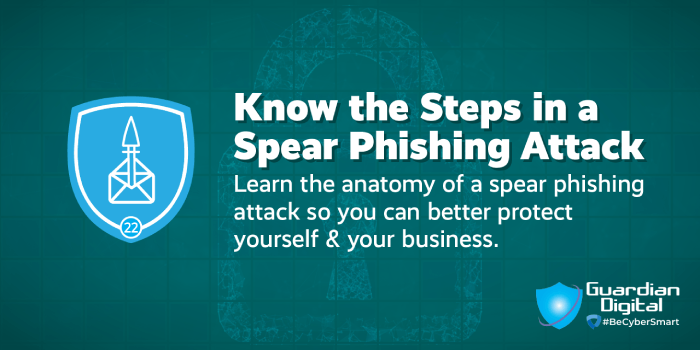Tip - Know the Steps in a Spear Phishing Attack

Learn the anatomy of a spear phishing attack so you can better protect yourself & your business.
Spear phishing attacks are the far more dangerous form of phishing that includes targeted, personalized messages more inclined to be trusted by the recipient.
Attackers sending spear phishing emails design emails after having researched their victims to have the greatest effect, collect the most money, or steal user credentials.
Not every phishing attack is delivered in bulk to thousands of users as the most serious are designed to deceive us personally. To help out, Guardian Digital presents the anatomy of a spear phishing attack.
Watch: Anatomy of a Spear Phishing Attack
Anatomy of a Spear Phishing Attack
Phase 1: Research
Spear phishing attacks begin by selecting people to target, especially spear phishing attacks as they take extra time to learn about those in their target lists.
These target lists value quality over quantity as attackers need to find enough information about each victim before hitting them with spear phishing attacks to easily pretend to know them.
Attackers learn their targets by looking at information that companies publish, like facts on their websites and social media, but attackers also get more information by exploiting data breach.
Phase 2: Develop
Attackers now craft emails with suspicious links or malicious payloads as they formulate the content that will be used to steal your identity or convince you to wire funds.
There’s many ways they do this, like building malware payloads, which are codes created that tell your computer to do harmful things, but some just ask for what they want instead through mimicry.
Since attackers mimic others, they create websites similar to those impersonated to get payloads into victims’ computers or fool them into giving login credentials with fake login screens.
Phase 3: Deceive
Now that the attack is built, it is time for cybercriminals to launch their campaign by executing the attack on their targets.
Cybercriminals are called threat actors because they build a persona that requires spoofing and acting like a trusted entity.
In spear phishing, attackers dig up lots of personal details about you for the most convincing ploy. Is that email from Paypal really from Paypal?
Phase 4: Retrieve
If the act fools someone into clicking a link or attachment in a spear phishing email, the cybercriminals then put their malicious payload to work to reap the rewards they desire.
Fake Microsoft 365 login pages, bank account change requests, or bogus package delivery notices, the threat actors are ingenious and inventive in their attempts to hide their actions.
Spyware is often loaded from advanced phishing attacks as it tracks everything before giving sensitive information to the attacker, like credit card information they monetize, leaving the target in a bad position.
How Can I Secure Business Email Against Spear Phishing Attacks?
You may be worried that spear phishing emails will fool a coworker, but an email security solution with auto-learning technologies that can prevent attacks from reaching the inbox is crucial in the fight against them.
Guardian Digital EnGarde Cloud Email Security has the technology necessary to proactively learn and distribute defenses for the specific threats targeting your company.
Want to see EnGarde in action? Get a Live Demo>>
Phishing Is Evolving
CyberSecurity Month
- Tip - Avoid Phishing Emails
- Tip - Being Cautious of Spam Email
- Tip - Be Wary of Malicious URLs
- Tip - Protect Against Spoofing & Sender Fraud
- Tip - Protect the Privacy of Your Email with TLS
- Tip - Don't Rely on Native Microsoft 365 Email Protection Alone
- Tip - Implement TLS to Keep Your Email Secure
- Tip - Endpoint Security Is Not Enough
- Tip - Conduct Regular Email Security Audits
- Tip - Configure Email Account Settings with Security in Mind
- Tip - Learn How To Spot Threats to Business Email
- Tip - Backing up Your Data and Isolate Your Backups Offline
- Tip - Protect Business Email from Phishing Attacks
- Avoid Sending Sensitive Information Over Email
- Tip - Learn About Malicious Links
- Tip - Prevent Zero-Day Attacks
- Tip - Business Email Is for Business Only
- Tip - Learn How To Identify Social Engineering Attacks
- Tip - Know Your Email Risk
- Tip - Safeguard Your Inbox from Malicious Mail
- Tip - Understand How Phishing Attacks Are Carried Out
- Tip - Know the Steps in a Spear Phishing Attack
- Tip - Familiarize Yourself with the Anatomy of a Whaling Attack
- Tip - Understand How Malware Attacks Work
- Tip - Learn the Steps in a Ransomware Attack
- Tip - Understand the Phases of a Business Email Compromise (BEC) Attack
- Tip - Know What Zero-Day Attack Is & How It Works
- Tip - Familiarize Yourself with the Phases of an Account Takeover (ATO) & Lateral Phishing Attack
- Tip - Learn the Steps in a Social Engineering Attack
- Tip - Understand the Types of Email Viruses to Be on the Lookout For